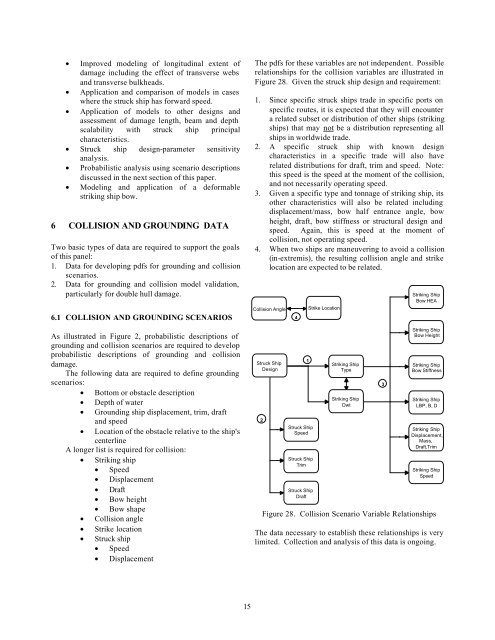Structural Design and Response in Collision and Grounding
Structural Design and Response in Collision and Grounding
Structural Design and Response in Collision and Grounding
Create successful ePaper yourself
Turn your PDF publications into a flip-book with our unique Google optimized e-Paper software.
• Improved model<strong>in</strong>g of longitud<strong>in</strong>al extent ofdamage <strong>in</strong>clud<strong>in</strong>g the effect of transverse webs<strong>and</strong> transverse bulkheads.• Application <strong>and</strong> comparison of models <strong>in</strong> caseswhere the struck ship has forward speed.• Application of models to other designs <strong>and</strong>assessment of damage length, beam <strong>and</strong> depthscalability with struck ship pr<strong>in</strong>cipalcharacteristics.• Struck ship design-parameter sensitivityanalysis.• Probabilistic analysis us<strong>in</strong>g scenario descriptionsdiscussed <strong>in</strong> the next section of this paper.• Model<strong>in</strong>g <strong>and</strong> application of a deformablestrik<strong>in</strong>g ship bow.6 COLLISION AND GROUNDING DATATwo basic types of data are required to support the goalsof this panel:1. Data for develop<strong>in</strong>g pdfs for ground<strong>in</strong>g <strong>and</strong> collisionscenarios.2. Data for ground<strong>in</strong>g <strong>and</strong> collision model validation,particularly for double hull damage.6.1 COLLISION AND GROUNDING SCENARIOSAs illustrated <strong>in</strong> Figure 2, probabilistic descriptions ofground<strong>in</strong>g <strong>and</strong> collision scenarios are required to developprobabilistic descriptions of ground<strong>in</strong>g <strong>and</strong> collisiondamage.The follow<strong>in</strong>g data are required to def<strong>in</strong>e ground<strong>in</strong>gscenarios:• Bottom or obstacle description• Depth of water• Ground<strong>in</strong>g ship displacement, trim, draft<strong>and</strong> speed• Location of the obstacle relative to the ship'scenterl<strong>in</strong>eA longer list is required for collision:• Strik<strong>in</strong>g ship• Speed• Displacement• Draft• Bow height• Bow shape• <strong>Collision</strong> angle• Strike location• Struck ship• Speed• DisplacementThe pdfs for these variables are not <strong>in</strong>dependent. Possiblerelationships for the collision variables are illustrated <strong>in</strong>Figure 28. Given the struck ship design <strong>and</strong> requirement:1. S<strong>in</strong>ce specific struck ships trade <strong>in</strong> specific ports onspecific routes, it is expected that they will encountera related subset or distribution of other ships (strik<strong>in</strong>gships) that may not be a distribution represent<strong>in</strong>g allships <strong>in</strong> worldwide trade.2. A specific struck ship with known designcharacteristics <strong>in</strong> a specific trade will also haverelated distributions for draft, trim <strong>and</strong> speed. Note:this speed is the speed at the moment of the collision,<strong>and</strong> not necessarily operat<strong>in</strong>g speed.3. Given a specific type <strong>and</strong> tonnage of strik<strong>in</strong>g ship, itsother characteristics will also be related <strong>in</strong>clud<strong>in</strong>gdisplacement/mass, bow half entrance angle, bowheight, draft, bow stiffness or structural design <strong>and</strong>speed. Aga<strong>in</strong>, this is speed at the moment ofcollision, not operat<strong>in</strong>g speed.4. When two ships are maneuver<strong>in</strong>g to avoid a collision(<strong>in</strong>-extremis), the result<strong>in</strong>g collision angle <strong>and</strong> strikelocation are expected to be related.<strong>Collision</strong> AngleStruck Ship<strong>Design</strong>241Struck ShipSpeedStruck ShipTrimStruck ShipDraftStrike LocationStrik<strong>in</strong>g ShipTypeStrik<strong>in</strong>g ShipDwt3Strik<strong>in</strong>g ShipBow HEAStrik<strong>in</strong>g ShipBow HeightStrik<strong>in</strong>g ShipBow StiffnessStrik<strong>in</strong>g ShipLBP, B, DStrik<strong>in</strong>g ShipDisplacement,Mass,Draft,TrimStrik<strong>in</strong>g ShipSpeedFigure 28. <strong>Collision</strong> Scenario Variable RelationshipsThe data necessary to establish these relationships is verylimited. Collection <strong>and</strong> analysis of this data is ongo<strong>in</strong>g.15
















